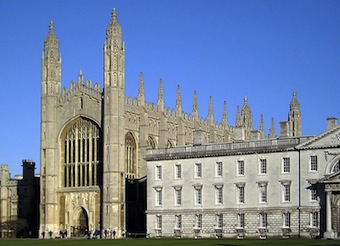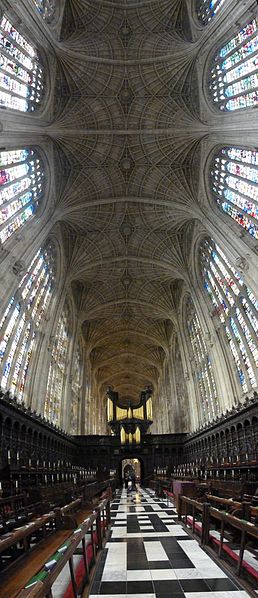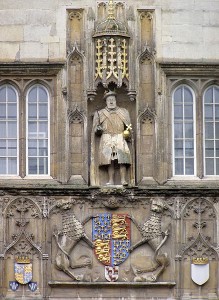Day 4
by Mike Glaeser
So much for Boswoth…I effectively audibled my audible. The end result is that I ended up on a train to Cambridge, situated one-hour north on the rails. In this large college town (though nothing like a US college town) are two schools with heavy ties to the Tudors. King’s is up first and rightly so for an entire half of its structure is a monument to the Tudor dynasty.
Henry VI placed the first stone for a new chapel and college in the spring of 1441. History will recognize the last Lancastrian King as more of a benefactor than a leader; for within his reign, he managed to lose almost all the holdings in France as well as the support of his nobles. King’s is arguably his crowning achievement. At its completion in Henry VIII’s reign, the chapel would be 88 meters long, 12 wide and a staggering 24 meters tall. Its jewel is the stone-carved fan vaulted ceiling. The ceiling of the Lady Chapel within Westminster Abbey is child’s play to this one in terms of sheer scope. In fact, the King’s ceiling is the largest freestanding fan vaulted ceiling in the world.
Henry VI would never live to see the chapel’s completion, having been first deposed and then murdered in the Tower of London with the Wars of the Roses in full swing. His eventual successor, after a period of Yorkist kings, was Henry VII, the founder of the Tudor dynasty. It was he who carried on with the construction of the chapel seeing it as an opportunity to showcase the Tudor’s right to rule. This is not lost on the visitor as every section built after 1485 is covered in carved Tudor roses, portcullises, greyhounds (reference to Margaret Beaufort), and dragons. If you look hard enough, there is one Tudor rose in the north west corner that has a depiction of Elizabeth of York, Henry’s Queen.
Henry made his final payment to the chapel in the sum of 5000 pounds. You can still see the chest that carried this huge sum of money today in one of the side chapels.
The roof was completed in 1515 under a new King, Henry VIII. Like his father, Henry knew of the value of propaganda. He had all the stained glass installed, which depicts the life of Jesus. It is said that King’s has the finest collection of early renaissance glass in the world.
Having seen it, I believe it. Almost all the windows are original. The most telling is window 4D where king Solomon is receiving a gift from the Queen of Sheba. Henry had himself transposed into the artwork as Solomon himself. As for the queen, there are two theories. Professor Ives believes Sheba is represented by Anne Boleyn (Ives 249 – 250). He references an acronym cipher on a Holbein miniature that reads “Regina Saba”. Breaking it down, he believes (but admits he may be stretching it) that it stands for “Regina Salomonem Anna Boleyn Amat” or “Anne Boleyn the Queen loves Solomon” (Ives 237). I have seen numerous other sources claim that the figure is Catherine Howard, Henry’s fifth wife.
If that is so, we have perhaps the only image of her, as no other images of her are known to exist. The painting that is always used to depict Catherine has actually turned out to be one of Jane Seymour’s sisters.
The glass is not the only spot where Henry has branded himself into the structure. As a gift to Anne Boleyn, Henry had a massive organ screen inserted into the middle chapel effectively dividing it into two halves. This screen is hand carved from dark oak and incorporates his ciphers, mottoes and imagery. More importantly, it is also one of the few remaining items in existence that still bears the ciphers and imagery of Anne Boleyn! If you look up at the coffers of the screen, you’ll see HA and RA as well as falcons rampant with the staff and crown. This means the screen was built between Anne’s years as Queen 1533-1536. Plenty of documentary evidence to share upon my return!
In the side chapel which now houses an exhibition on the construction of the church, you can find stained glass windows of a crowned fleur d’ lys with an HA cipher below…another reference to Anne. I also found glass with the heraldry of Katherine of Aragon, Jane Seymour, Catherine Howard and Catherine Parr. All but Anne of Cleves are present. This makes me question whether the glass is authentic or a later addition to play on the chapel’s ties to Henry VIII.
A short walk away is Trinity College that was founded by Henry VIII.
As a reward, the 14th century gatehouse has his statue, which I believe is the only outside statue of the King anywhere in England. Please let me know if I’m wrong. One of the other entranceways is called the Queen’s Gate that has a statue of Queen Elizabeth.
My Cambridge journey complete, I headed back to London for a quick visit to the British Library. Sadly, there is next to nothing on exhibition linked to the Tudors. The only display I did see, however, makes up for it. Unfurled to its full 14 feet in length was Henry’s (Prince of Wales) prayer roll. Illuminated with moralistic teachings, Henry’s tutors had him study and memorize it. Dr. Starkey touches upon this roll in his series “Henry: Mind of a Tyrant”.
One last success of the day, I walked into an antique book store and came out with several prints of Tudor figures used in “The History of England” by Paul de Rapin-Thoyras (1747). Originally engraved in copper, these pieces of art were then printed in Rapin’s monumental work. For those wondering, I have Henry, Jane and Cardinal Wolsey. I also found two prints showing the tomb of Henry VII. Some slight changes are visible from what we now see at Westminster today.
Now then, on to day five!




















Amazing – you will need to show me those prints.
Thanks for the account Mike; you write really well have a great eye for detail. It is also interesting to hear what is going on in some of the lesser known places like the british Library – which i am shortly planning to visit. Keep up the good work and enjoy the rest of your holiday even though the weather leaves a little to be desired!
Looking forward to Day 5. Your entries have been very inspiring and I’m looking forward to my trip to England to visit some of these places I’ve longed to see forever!
I am a direct decendant of John Manistre, era 1600. There are records in my research that state his donation to the King’s college for the library. I woul reall love to know more about it as my granddaughter took classes there while at NYU. Are you familiar with the Manistre line? Thankyou for any information you can share.